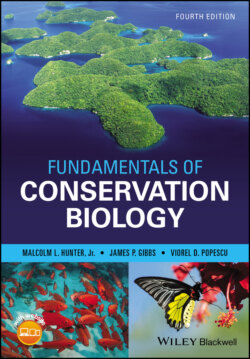Читать книгу Fundamentals of Conservation Biology - Malcolm L. Hunter Jr. - Страница 32
The Mismeasure of Biodiversity
ОглавлениеOften, being precise and quantitative will reveal solutions to a difficult problem, but using quantitative indices of diversity can be misleading when maintaining biodiversity is the goal. Consider the following three lists of species, each one representing (in very abbreviated form) a sample of the species found in three different types of ecosystems.
| Forest | Marsh | Grassland |
| Black oak | Reed‐grass | White prairie‐clover |
| American toad | Painted turtle | Horned lark |
| Eastern racer | Red‐winged blackbird | Black‐footed ferret |
| Scarlet tanager | Muskrat | |
| Raccoon |
If someone were asked which of these tracts is most important from the perspective of maintaining biodiversity, one measure of biodiversity – species richness – would suggest that the forest be chosen. However, if you knew that the black‐footed ferret is one of the rarest mammals in the world and that all the other species listed are very common, you might well select the grassland tract. Why?
The simple answer is that all species may count the same when tallying species richness, but conservationists almost always consider additional information such as the likelihood of a species becoming extinct, its role in an ecosystem, and more. Consequently, not all species are equal from a conservation perspective. We will return to this issue in other chapters, but we need to build a foundation here by considering how conservation decisions are shaped by patterns of diversity and risk of extinction at different spatial scales.
